1. Introduction
Let’s start by reviewing two key types of evidence for evolution: homologous and vestigial structures.
[qdeck qrecord_id=”sciencemusicvideosMeister1961-Homology, Analogy, Vestigial traits Review (HS)”]
[h]Homologous and Vestigial Structures: review
[q]Define homologous structures.
[a]Homologous structures are structures that are inherited from a common ancestor and which have evolved different functions.
[q]How do we know that the similarly named and colored bones shown below are the same bones?
[a]We know that these are the same bones because of their similar position and relationship to one another and because they develop from the same tissue in the embryo of each animal.
[q]Define adaptive radiation.
[a]Adaptive radiation is the process by which one ancestral species splits into multiple descendants.
[q]What’s the connection between adaptive radiation and homologous structures?
[a]Adaptive radiation is the process by which one ancestral species splits into multiple descendants. In each line of descent, structures in the ancestor evolve into structures used in different ways by each descendant. As a result, each of the structures in the descendants has a similar structure, but that structure is modified for different functions.
[q]Define vestigial structure.
[a]A vestigial structure is a structure that has lost its function, and only remains in a reduced form.
[q]Why are homologous and vestigial structures evidence for evolution?
[a]Both homologous and vestigial structures could only exist if they were inherited from ancestral species. In other words, both show descent with modification, which is the basis of evolution.
[x]
[restart]
[/qdeck]
2. Embryology as Evidence for Evolution
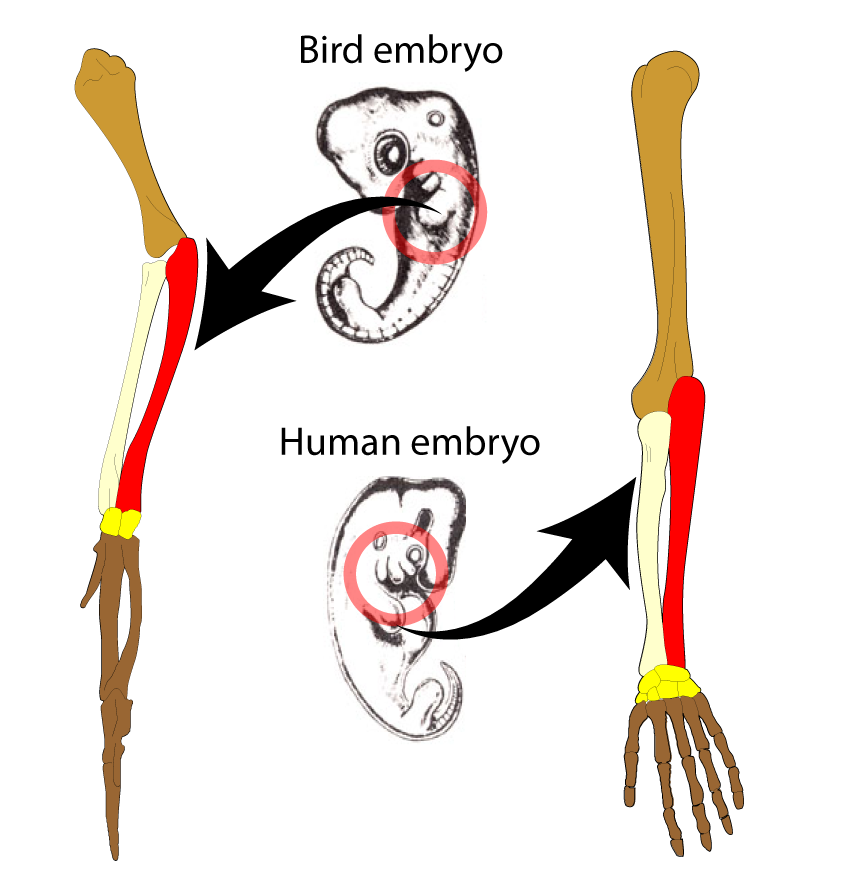 As stated in one of the cards above, one way that we know that a structure is homologous is because it originates in a similar patch of tissue in the embryo of each animal. In the diagram to the left, the same patch of tissue develops into the wing of a bird, and the arm of a human being. As the animal develops into its adult form, the structure becomes modified to serve a different function.
As stated in one of the cards above, one way that we know that a structure is homologous is because it originates in a similar patch of tissue in the embryo of each animal. In the diagram to the left, the same patch of tissue develops into the wing of a bird, and the arm of a human being. As the animal develops into its adult form, the structure becomes modified to serve a different function.
Let’s look at a few more embryos. The images below show embryos from different types of vertebrates — animals with backbones — at equivalent phases of development. The top row consists of photographs with some modifications (a yolk sac removed in the salamander). The bottom row shows drawings from Ernst Haeckel, a famous 19th-century biologist.
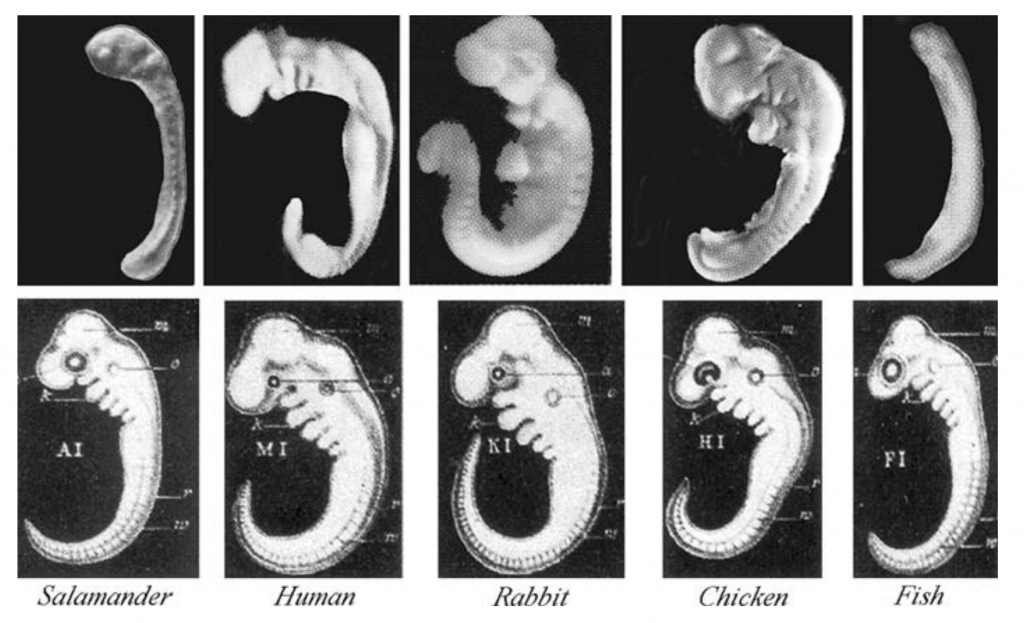
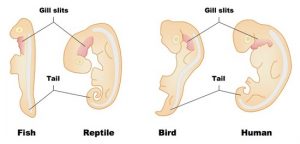
The similarity in embryonic form provides two additional pieces of evidence for evolution. First, the similarity of form is a homology. The pattern of development shows that these animals are descended from a common ancestor.
Second, comparing embryos also provides us with additional evidence for evolution related to vestigial traits.
- Gill slits appear in humans, rabbits, and chickens. Gill slits are openings from the back of the head into the mouth. Fish use them to pass water over their gills through which they absorb oxygen from water. These disappear later in development.
- Tails appear in humans and chickens and disappear later in development.
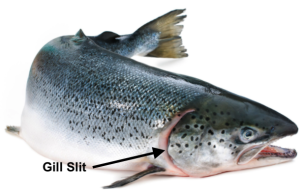 Why do animals such as humans, rabbits, and chickens, during development, expend the energy to create gill slits, only to break them down and absorb them later? It’s because having gill slits is a part of a developmental pattern inherited from a vertebrate ancestor. In early embryos, the genes for this plan are still expressed.
Why do animals such as humans, rabbits, and chickens, during development, expend the energy to create gill slits, only to break them down and absorb them later? It’s because having gill slits is a part of a developmental pattern inherited from a vertebrate ancestor. In early embryos, the genes for this plan are still expressed.
The same is true of the tail. All vertebrate embryos have a pronounced tail. That includes animals like humans and birds, which as adults don’t have tails. Why do these embryos have tails? Because having a tail is a vestigial trait. It’s a vestige of a developmental pattern inherited from a common ancestor.
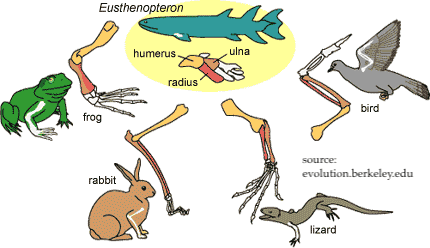 What’s the takeaway? Embryological development allows us to more clearly see the homologies that come about through adaptive radiation.
What’s the takeaway? Embryological development allows us to more clearly see the homologies that come about through adaptive radiation.
- All vertebrates descend from a common ancestor.
- As vertebrates develop, their body plan unfolds in a way common to all vertebrates. That embryonic pattern is itself a homology.
- As development continues, the form of each lineage diverges. The same patch of tissue will develop into a wing of a bird or the forelimb of a lizard, rabbit, or frog.
- The homologous structure of the forelimb in the adult form of each animal reflects adaptive radiation from a common ancestor.
Finally, note that this same pattern of embryonic similarity followed by development into diverse forms can be found in any other clade (a group of organisms descended from a common ancestor). You can learn about the differentiation of insect mouthparts in this article on Wikipedia.
3. Flashcards: Embryological Evidence for Evolution
[qdeck qrecord_id=”sciencemusicvideosMeister1961-Embryological Evidence (HS)”]
[h]Embryos as evidence for evolution
[q]Why is the similar embryonic form of related animals (such as vertebrates) evidence for evolution?
[a]The similar embryonic form of related animals (such as vertebrates) is evidence for evolution because shows descent from a common ancestor.
[q]How can you explain the appearance of features like gill slits and tails during human development, even though these structures disappear later?
[a]Embryonic gill slits and a tail are vestigial features. Their appearance reflects a pattern of development that we inherited from an ancestor.
[q]What’s the connection between embryological development, adaptive radiation, and homologous structures?
[a]As shown by their homologous structures and common pattern of embryonic development, all vertebrates are descended from a common ancestor. That common ancestor, through adaptive radiation, evolved into different forms.
[x]
[restart]
[/qdeck]
4. Molecular Homologies
Above and in previous tutorials, we’ve discussed how homologous structures serve as evidence for evolution. Molecules can be homologous too, establishing another line of evidence for evolution.
The table below shows two proteins that are widely shared among many species.
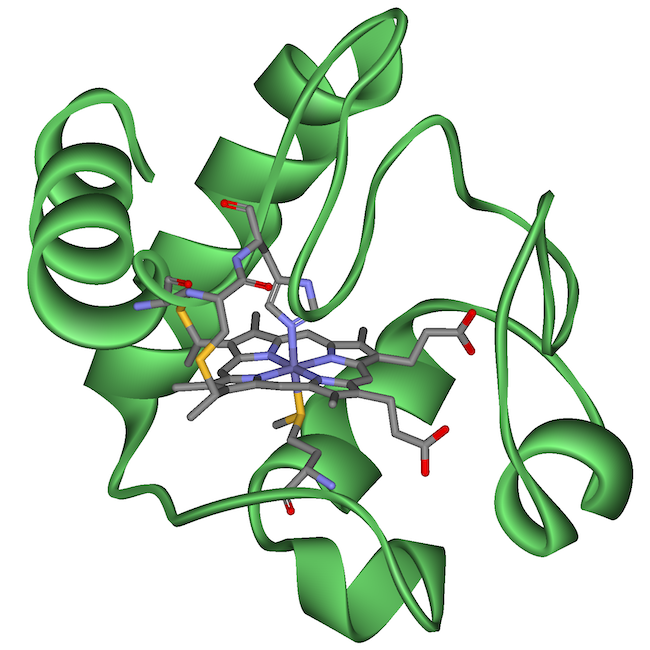 |
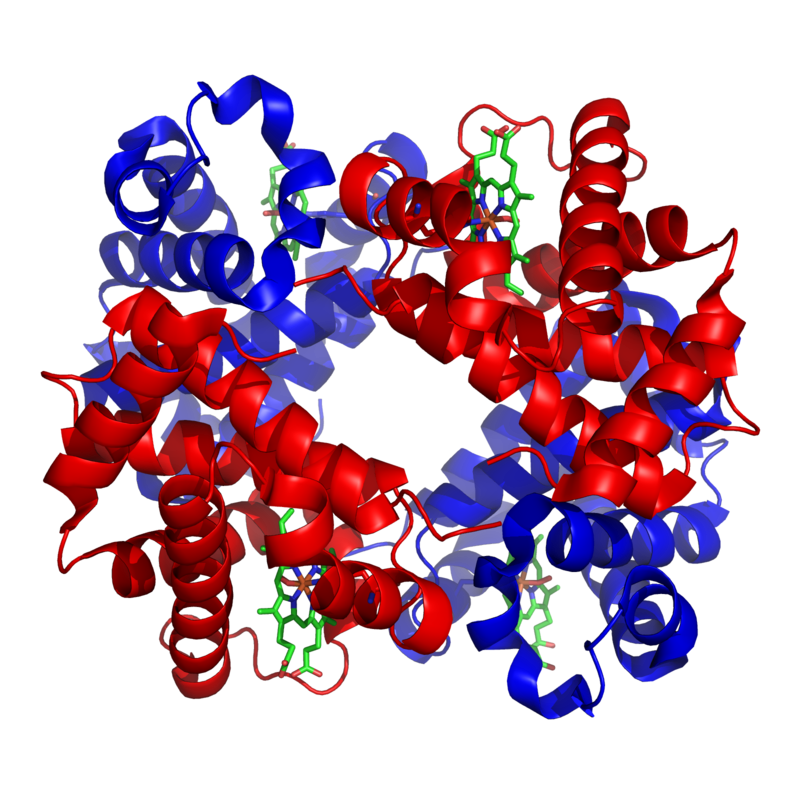 |
| Cytochrome c is a protein that’s used in cellular respiration. | Hemoglobin is a protein used to carry oxygen in red blood cells. |
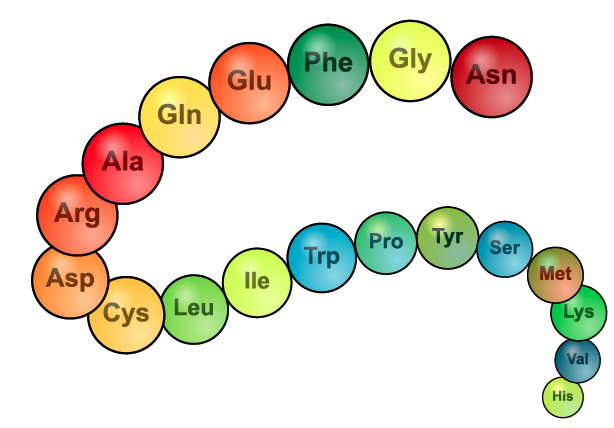
Proteins are one of the key molecules in living things. If you want to review protein structure in depth, you can do so at this Learn-Biology.com tutorial. But for what’s below, you just need to know that proteins are built from subunits called amino acids. A chain of amino acids is shown at right. The type of amino acids making up a protein, and the order in which these amino acids are linked together, determine the protein’s three-dimensional structure.
Cytochrome c and hemoglobin are found in many species with either an identical or highly similar sequence of amino acids and a correspondingly similar three-dimensional shape. Why do so many different species share these molecules? Because they inherited the genes for making these molecules from a common ancestor.
To learn more, complete the following interactive reading.
[qwiz qrecord_id=”sciencemusicvideosMeister1961-Molecular Homologies Interactive Reading (HS)”]
[h] Interactive Reading: Molecular Homologies and Evolution
[i]
[q labels = “top”]Cytochrome c is a protein that’s built of 104 linked _________ acids. We’ve previously discussed how the forelimbs of all vertebrates (animals with backbones) are ______________. The same is true of cytochrome c. Both the forelimb structure in vertebrates and the cytochrome c structures shared by vertebrates (and other species without backbones) were derived from a common ______________, and _____________ in the descendants.
[l]ancestor
[f*] Excellent!
[fx] No, that’s not correct. Please try again.
[l]amino
[f*] Good!
[fx] No. Please try again.
[l]modified
[f*] Great!
[fx] No, that’s not correct. Please try again.
[l] homologous
[f*] Correct!
[fx] No. Please try again.
[q labels = “top”]The next slide will show a table that shows the number of amino acid differences found between the cytochrome c molecules of human beings and seven other species. In the table, the species names aren’t filled in yet (that’s your job). The more closely __________ a species is to human beings, the fewer _____________ we’d expect to find in the amino acids that make up this protein. Use that hint to complete the table on the next slide.
[l]differences
[f*] Correct!
[fx] No, that’s not correct. Please try again.
[l]related
[f*] Good!
[fx] No. Please try again.
[q labels = “right”]Use logic and trial-and-error to complete the table below. Don’t worry about getting a wrong answer (but remember the hint from the previous slide: the more closely related a species is to human beings, the fewer amino acid differences it will have).
| Organism | Number of amino acid differences from humans |
| ___________________ | 0 |
| ___________________ | 1 |
| ___________________ | 9 |
| Pigeon | 12 |
| ___________________ | 18 |
| ___________________ | 25 |
| Yeast | 40 |
[l]Bullfrog
[f*] Good!
[fx] No. Please try again.
[l]chimpanzee
[f*] Correct!
[fx] No. Please try again.
[l]Fruit fly
[f*] Good!
[fx] No. Please try again.
[l]Rabbit
[f*] Great!
[fx] No. Please try again.
[l]Monkey
[f*] Great!
[fx] No. Please try again.
[q labels = “top”]This cytochrome c data confirms other aspects of biology. For example, of the other species in this list, chimpanzees are, in terms of their anatomy and behavior, the most _____________ to humans. Therefore it makes sense that their amino acid sequence for this key protein would be ____________ to the human sequence. Of the mammals listed, the _________ is more different from humans than is the monkey. Therefore, it makes sense that the rabbit’s cytochrome c amino acid sequence would, from among the mammals in the table, also be the most ____________ from the human sequence.
[l]different
[f*] Good!
[fx] No, that’s not correct. Please try again.
[l]identical
[f*] Excellent!
[fx] No. Please try again.
[l]rabbit
[f*] Excellent!
[fx] No. Please try again.
[l]similar
[f*] Great!
[fx] No. Please try again.
[q labels = “top”]The key idea is that the cytochrome c shared by the organisms below is a ________________ structure. The organisms below share it because they inherited the genes for this molecule from a common ______________. Of the organisms below, our most distant relative is ______________ (which, unlike every other organism on the list, is not an ____________, but a fungus). As our most distant relative, it makes sense that its cytochrome c would also be the most _____________. But despite these differences, we still share a common ancestor with yeast. Evolutionarily speaking, it’s our distant ___________.
[l]ancestor
[fx] No. Please try again.
[f*] Good!
[l]animal
[fx] No, that’s not correct. Please try again.
[f*] Excellent!
[l]cousin
[fx] No, that’s not correct. Please try again.
[f*] Good!
[l]different
[fx] No, that’s not correct. Please try again.
[f*] Correct!
[l]homologous
[fx] No, that’s not correct. Please try again.
[f*] Excellent!
[l]yeast
[fx] No. Please try again.
[f*] Correct!
[q] Let’s learn a bit more about hemoglobin. This is a protein that transports oxygen in red blood cells. The protein consists of four amino acid chains. Two are 141 amino acids long. The other two are 146 amino acids long.
[q labels = “top”]Complete this list of amino acid differences between one of the hemoglobin chains in humans and the corresponding chain in several other species.
[l]27
[f*] Correct!
[fx] No, that’s not correct. Please try again.
[l]one
[f*] Good!
[fx] No, that’s not correct. Please try again.
[l]45
[f*] Good!
[fx] No. Please try again.
[l]eight
[f*] Good!
[fx] No, that’s not correct. Please try again.
[l]62
[f*] Excellent!
[fx] No. Please try again.
[q labels = “top”]The presence of hemoglobin in all of the animals below is a molecular _______________. All of these animals have hemoglobin because they inherited it from a common ______________. The amount of molecular similarity reflects the amount of similarity in body form and other features. Of the animals below, the one most similar to humans is the ______________. The similarity in body structure is matched by the similarity in the _______________ making up hemoglobin, which only differs by _______. The more _____________ the animal is from a human being, the more differences will be found in the ___________ in their red blood cells.
[l]amino acids
[fx] No. Please try again.
[f*] Great!
[l]ancestor
[fx] No, that’s not correct. Please try again.
[f*] Good!
[l]different
[fx] No. Please try again.
[f*] Good!
[l]gorilla
[fx] No, that’s not correct. Please try again.
[f*] Excellent!
[l]hemoglobin
[fx] No. Please try again.
[f*] Great!
[l]homology
[fx] No. Please try again.
[f*] Correct!
[l]one
[fx] No, that’s not correct. Please try again.
[f*] Good!
[x][restart]
[/qwiz]
What’s the takeaway? The sharing of common proteins like cytochrome c and hemoglobin among animals isn’t unusual. Most of the proteins found in human beings are also found in other animals. The sharing of these proteins is a homology, indicating descent from a common ancestor.
What’s true of proteins is also true of genes. Based on how the term “gene” is defined, humans have between 20,000 and 25,000 genes. Almost all of these genes are also found in other animals. These shared genes are, like the proteins they code for, homologies. We share these genes with other animals because we inherited them from a common ancestor.
Here are two examples:
- Genes coding for eye development: A gene called eyeless codes for eye formation in fruit flies (and other insects). This insect gene is homologous to a gene called small eye in mice (and other mammals). How do we know that the genes are homologous? First, because of the shared sequence of nucleotide bases in each gene. Second, because of a series of experiments in which these genes were transferred from fruit flies to mice, and vice versa. The eyeless gene has been experimentally inserted into mutant mice embryos that are from a strain of mice that don’t develop eyes. With the fruit fly gene, these mice produce eyes. The reverse is also true. Insert the mouse gene into embryos of mutant fruit flies that don’t develop eyes, and eyes will develop.
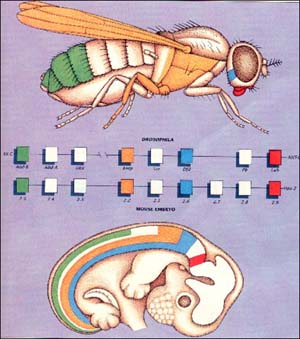 Genes coding for body segments: Almost all animals are built using a similar developmental plan. The plan involves the development of a head, a middle region, and a hind region. In many animals, these regions can be subdivided into segments. The genes that control how each segment develops are called Hox genes, and they’re shared between insects and mammals. How do we know they’re homologous? Because of shared sequence, and because of gene transfer experiments. In other words, the same gene that directs the formation of structures on the head in an insect also directs the formation of a head in mammals (including you). These genes are shown in red in the diagram to the right. The same is true of the structures on the rest of the body, from head to tail (even if your tail is just a vestige).
Genes coding for body segments: Almost all animals are built using a similar developmental plan. The plan involves the development of a head, a middle region, and a hind region. In many animals, these regions can be subdivided into segments. The genes that control how each segment develops are called Hox genes, and they’re shared between insects and mammals. How do we know they’re homologous? Because of shared sequence, and because of gene transfer experiments. In other words, the same gene that directs the formation of structures on the head in an insect also directs the formation of a head in mammals (including you). These genes are shown in red in the diagram to the right. The same is true of the structures on the rest of the body, from head to tail (even if your tail is just a vestige).
What do these genetic homologies tell us? That mice and fruit flies share a common ancestor from which they both inherited the same genes for eye development and body segment identity. That common ancestor existed 500 million years ago when the line leading to vertebrates split apart from the line leading to arthropods (insects, crabs, spiders, etc.) And just to make this personal, that means that insects are our very ancient cousins. Think of that the next time you swat a fly.
5. Flashcards: Molecular Evidence for Evolution
[qdeck qrecord_id=”sciencemusicvideosMeister1961-Molecular Evidence (HS)”]
[h]Molecular evidence for evolution
[q]Shared molecules such as cytochrome c and hemoglobin are evidence for evolution because
[a]Shared molecules such as cytochrome c and hemoglobin are evidence for evolution because these molecules are homologous. The species that share must have had a common ancestor.
[q]Cytochrome c is a protein used in _____________ ________________. It’s widely shared among eukaryotic species and is found in [try to list a few other species that also use cytochrome c]
[a]Cytochrome c is a protein used in cellular respiration. It’s widely shared among eukaryotic species and is found in such species as humans, other mammals, insects, and even yeast.
[q]Proteins that are shared among species show a predictable pattern. The more closely the species are related…
[a]Molecules that are shared among species show a predictable pattern. The more closely the species are related the more the sequence of amino acids in those proteins will overlap.
[q]How does the information in the image below serve as evidence of evolution?
[a]The information in the diagram below provides two pieces of evidence for evolution. First, the fact that humans and animals share hemoglobin is evidence of homology on a molecular level. We share hemoglobin with these species because we share a common ancestor. Second, the degree to which our hemoglobin is similar matches and confirms homologies that are based on structure.
[q]Of the animals shown below, the greatest difference in hemoglobin is between humans and __________. That indicates that…
[a]Of the animals shown below, the greatest difference in hemoglobin is between humans and frogs. That indicates that humans and frogs are the least closely related, and share the most distant common ancestor.
[q]We share most of the 20,000 or so genes in the human genome with other animals. That’s evidence that …
[a]We share most of the 20,000 or so genes in the human genome with other animals. That’s evidence that we share a common ancestor with other animals.
[q]A spectacular example of homologous genes involves the genes for _____________. Mammals share these genes with _____________, which indicates that we
[a]A spectacular example of homologous genes involves the genes for eye development and body segment formation. Mammals share these genes with insects, which indicates that we share a common ancestor with insects. That common ancestor lived about five hundred million years ago.
[q]Explain the diagram below.
[a]The diagram shows how the genes that control which structures grow on which body segment — Hox genes — are homologous between insects and mammals. That homology points to a common ancestor that we share with insects.
[x][restart]
[/qdeck]
6. Checking Understanding Quiz: Embryonic and Molecular Evidence for Evolution
[qwiz qrecord_id=”sciencemusicvideosMeister1961-Embryonic and Molecular Evidence Quiz (HS)”]
[h]Embryonic and Molecular Evidence for Evolution
[i]
[q] The embryos of vertebrates such as fish, birds, and mammals develop in similar ways because all of these animals share a common [hangman].
[c]IGFuY2VzdG9y[Qq]
[f]IEdyZWF0IQ==[Qq]
[q] Embryos of humans show various [hangman] traits such as a tail or gill slits that are not present in the adult form.
[c]IHZlc3RpZ2lhbA==[Qq]
[q] The common developmental pattern shown by these vertebrate embryos is evidence of [hangman] with [hangman] from a common ancestor.
[c]IGRlc2NlbnQ=[Qq]
[f]IEV4Y2VsbGVudCE=[Qq]
[c]IG1vZGlmaWNhdGlvbg==[Qq]
[f]IENvcnJlY3Qh[Qq]
[q] Hemoglobin and cytochrome c are both examples of [hangman] at the molecular level.
[c]IGhvbW9sb2dpZXM=[Qq]
[f]IENvcnJlY3Qh[Qq]
[q] Based on molecular data like that shown in the table below, one can infer how closely [hangman] two species are.
[c]IHJlbGF0ZWQ=[Qq]
[f]IENvcnJlY3Qh[Qq]
[q] The more similar the amino acid [hangman] in a protein shared by two species, the more closely related they are.
[c]IHNlcXVlbmNl[Qq]
[f]IEV4Y2VsbGVudCE=[Qq]
[q multiple_choice=”true”] Which of the following statements about human genes is most correct?
[c]IEh1bWFucyBhcmUgdW5pcXVlIGJlY2F1c2UgbW9zdCBvZiBvdXIgZ2VuZXMgYXJlIHVuaXF1ZSB3aXRoaW4gdGhlIGFuaW1hbCBraW5nZG9t[Qq]
[f]IE5vLiBPZiB0aGUgMjAsMDAwICYjODIxMTsgMjUsMDAwIGdlbmVzIGluIHRoZSBodW1hbiBnZW5vbWUsIG9ubHkgYSBmZXcgZG96ZW4gYXJlIHVuaXF1ZSB0byBvdXIgc3BlY2llcy4=[Qq]
[c]IEFsbW9zdCBhbGwgaHVtYW4gZ2VuZXMgaGF2ZSBhIGhvbW9s b2dvdXMgY291bnRlcnBhcnQgaW4gb3RoZXIgYW5pbWFscw==[Qq]
[f]IFllcy4gT2YgdGhlIDIwLDAwMCAmIzgyMTE7IDI1LDAwMCBnZW5lcyBpbiB0aGUgaHVtYW4gZ2Vub21lLCBvbmx5IGEgZmV3IGRvemVuIGFyZSB1bmlxdWUgdG8gb3VyIHNwZWNpZXMuIEFsbCB0aGUgb3RoZXJzIGhhdmUgaG9tb2xvZ291cyBjb3VudGVycGFydHMgaW4gb3RoZXIgc3BlY2llcy4=[Qq]
[c]IEFib3V0IGhhbGYgb2YgaHVtYW4gZ2VuZXMgYXJlIHVuaXF1ZSB0byBodW1hbiBiZWluZ3Mu[Qq]
[f]IE5vLsKgT2YgdGhlIDIwLDAwMCAmIzgyMTE7IDI1LDAwMCBnZW5lcyBpbiB0aGUgaHVtYW4gZ2Vub21lLCBvbmx5IGEgZmV3IGRvemVuIGFyZSB1bmlxdWUgdG8gb3VyIHNwZWNpZXMu[Qq]
[q] Genes or proteins that are widely shared among a variety of species are said to be highly conserved. These genes or proteins are molecular [hangman] and indicate common [hangman].
[c]IGhvbW9sb2dpZXM=[Qq]
[c]IGFuY2VzdHJ5[Qq]
[q] The Hox genes (shown below) control which kind of appendage grows on which body [hangman].
[c]IHNlZ21lbnQ=[Qq]
[q] The similar organization and sequence similarity in the hox genes indicate that these genes are [hangman] between insects and mammals.
[c]IGhvbW9sb2dvdXM=[Qq]
[q]The fact that both human and arthropod development is controlled by hox genes indicates that back in time, these animals share a [hangman] [hangman].
[c]IGNvbW1vbg==[Qq]
[c]IGFuY2VzdG9y[Qq]
[x][restart]
[/qwiz]
7. The Deepest Homologies
7a. Homologous features found in all eukaryotes
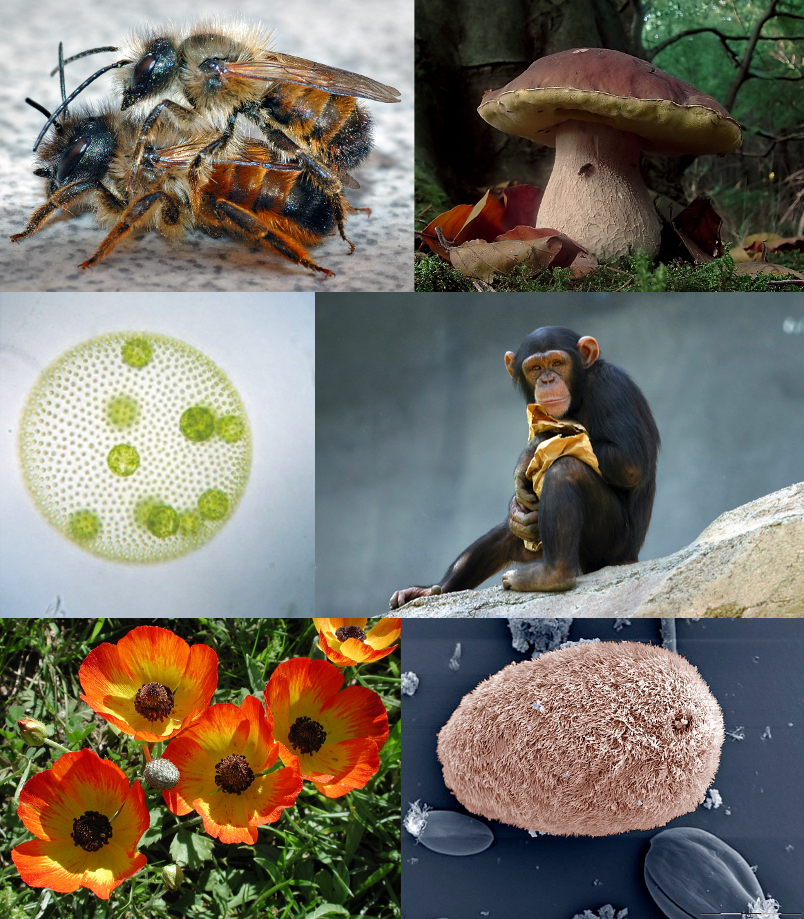
Our domain, the eukaryotes, arose about 1.5 billion years ago. Despite their incredible diversity, eukaryotes share a single common ancestor. How do we know? Because of the homologous features possessed by all eukaryotes.
Here’s a short list of the homologous features that all eukaryotes share.
- Mitochondria
- Complex cells with internal compartments such as the rough and smooth endoplasmic reticulum, the Golgi apparatus, and lysosomes.
- A membrane-bound nucleus encloses the cell’s chromosomes, separating the chromosomes from the cytoplasm.
- Linear chromosomes (as opposed to the circular chromosomes in bacteria and archaea).
Note that multicellularity is not a shared eukaryotic feature (because many eukaryotes are unicellular).
7b. Commonalities for all life
We can go one level deeper, from traits that unify eukaryotes to traits found in all living things.
All living things possess molecular and genetic homologies that point to one of the most profound insights from the study of biology: that all living things are related. We’re all cousins. “We,” in this context, doesn’t just mean all human beings (though that’s true). We’re also cousins to sparrows, leaf-cutter ants, oyster mushrooms, rhododendrons, kelp, Archaeans that live in hot springs, the photosynthetic bacteria that live in the oceans, and the E. coli bacteria that live by the billions in our guts.
To see what these homologies are, and to distinguish the conserved features of all life from the conserved features that bind together the eukaryotes, complete the quiz below.
[qwiz qrecord_id=”sciencemusicvideosMeister1961-Eukaryotic Homologies (We’re all Cousins)(HS)”]
[h]We’re all cousins
[i]
[q]One conserved homology is seen in the molecule that defines life: the genetic material [hangman]
[c]RE5B[Qq]
[q]All living things follow the central dogma of molecular genetics: ______________ makes _____________makes _______________.
[l]protein
[fx] No, that’s not correct. Please try again.
[f*] Good!
[l]RNA
[fx] No, that’s not correct. Please try again.
[f*] Great!
[l]DNA
[fx] No, that’s not correct. Please try again.
[f*] Correct!
[q]All living things synthesize their proteins using [hangman], shown at “2” below.
[c]cmlib3NvbWVz[Qq]
[q]All living things are composed of one or more [hangman].
[c]Y2VsbHM=[Qq]
[q]All living things use [hangman] to power cellular work.
[c]QVRQ[Qq]
[q]All living things translate their RNA into protein using the same genetic [hangman]
[c]Y29kZQ==[Qq]
[x]
[restart]
[/qwiz]
8. Flashcards: The Deepest Homologies
[qdeck qrecord_id=”sciencemusicvideosMeister1961-The Deepest Homologies (HS)”]
[q]What are four homologous features shared by all eukaryotes indicating that they share a common ancestor?
[a]Four homologous features shared by all eukaryotes indicating common ancestry include
- Cells with mitochondria
- Complex cells with internal compartments like the E.R. Golgi, and lysosomes.
- A membrane-bound nucleus separates chromosomes from the cytoplasm.
- Linear chromosomes.
[q]Homologous features shared by all living things, and which indicate that all living things descend from a common ancestor include
[a]Six homologous features shared by all living things, and which indicate that all living things descend from a common ancestor include
- DNA as the genetic material
- A system where DNA is transcribed into RNA, which is translated into protein.
- Using ribosomes to synthesize protein.
- Being composed of cells
- Using ATP to power cellular work.
- Using the same genetic code
[/qdeck]
Links
To finish this high school-level module on evidence for evolution, click the following link for a cumulative flashcard deck and quiz.
Or,
- Click to return to the Evidence for Evolution Main Menu (HS Level).
- Use the menus above to choose something else to learn.
